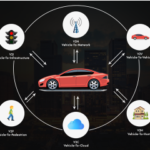A VANET (Vehicular Ad-Hoc Network), consists of different nodes, which are the constituting components forming the VANET network like cars, buses, and so. A certain area in a VANET system may consist of many nodes.
In a smart city model, smooth functioning of transportation depends on the seamless communication between the different nodes of the VANET. Connected and autonomous vehicles, self-driving cars, all form the VANET infrastructure and a successful smart-city transportation structure means a controlled communication between every node aspect of the system.
Wireless Communication in a VANET
A smart city is ideally called so because of the intelligent infrastructure that it possesses. A smart city VANET depends on its multiple characteristics including autonomy, network distributed control, routing and variable network topology. All these aspects have to be interconnected and must have a mechanism in place to control and regulate. An enhanced wireless sensor system is a core component that has the power to enable fast topology changes in high node mobility.
The networking system of a VANET processes the interconnection of different users from different gateways that supports the whole vehicular network.
While this network interconnection is integral to the success of VANET, the wireless sensors are the components that lay the hardware framework for making the entire model connect and interact internally, comprehensively and real-time, as per specific needs of the vehicular movement.
Impact of Wireless Sensors on VANET Nodes, Connected and Autonomous Vehicle(s) and/or Self-Driving Car
Sensors provide the channel through which vehicles and infrastructure in a smart city road transit system gather and monitor information. In wireless sensors there are not one but different categories – security sensors, functional sensors, informative sensors, and surveillance sensors. All of these work in a different way and has different output associated with them, like a GPS gathers data at the informative sensor function level.
Wireless sensors are the independent factors that work to screen multiple elements including physical circumstances like sound, temperature, moistness and so.
Application of Wireless Sensors
There are multiple applications of wireless sensors that contribute to how it impacts VANET, self-driving cars and autonomous vehicles:
• Traffic data framework corresponding to the vehicle’s satellite route records
• Electric brake light system and security systems of the vehicle
• Platooning which collects data corresponding to the quickening and controlling with respect to other vehicles in the vicinity
• Road transport emergency services which acts as the major point for accelerating crisis save activities enhancing security cautioning
• On-the-road services, meaning relay of data pertaining to presence of service stations, shops and so on a road for the vehicles nearby looking for certain information.
Methodology of Wireless Sensors
The core of the sensors: on-board sensors are the ones which a VANET information channel utilize to gather all the important information about the vehicle.
• Infrared sensor is aligned to the engine drive and as the wheel finish the turn, the data is transitioned to the IR system.
• Utilization of GPS has become one of the most important and highly utilized aspect of the position information system that helps discover its area ranges and need that information to channel the entire mobility needs in a VANET.
• Other sensor methods are utilized for varied other processes including pressure, humidity, temperature and more.
As the research and development still in place, the VANET communication protocols will go through several transformative phases. And wireless network sensors are going to play a huge role in all of that.


You have noted very interesting details! ps nice website.Money from blog
my blog post: Stuart P